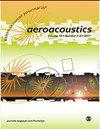Effect of sawtooth trailing edge serrations on the reductions of airfoil broadband noise
IF 1.2
4区 工程技术
Q3 ACOUSTICS
引用次数: 0
Abstract
The present paper examines the use of modified dual-wavelength sawtooth serrations introduced at the trailing edge (TE) of a National Advisory Committee for Aeronautics (NACA) 65 (12)-10 airfoil as a passive means for the control of airfoil broadband noise. The studies are conducted for different parameters such as serration wavelengths (λ), serration amplitudes (h) as well as (hꞌ) modified amplitude to determine the best serration parameter which provides higher noise reductions. The reduction of noise level brought by the modified dual-wavelength sawtooth serrations at the TE is about 4 dB, while it is about 3.3 dB for the simple ones. It reveals that the modified sawtooth can provide a substantial reduction of self-noise alongside the interaction noise over an extensive range of frequencies which indicates the existence of strong far-field destructive interference (i.e., feedback) from low to mid-frequency ranges (i.e., 1.5 - 5 kHz). The TE serrated airfoils show lower acoustic emissions as compared to baseline although they exhibit a common behavior for all emission angles. The large noise decrease provided by the dual-wavelength sawtooth may be because of the significant reductions in the scattering intensity of sound as well as strong far-field destructive interference owing to the presence of two roots between the two successive maximum amplitude peaks.锯齿状后缘锯齿对降低机翼宽带噪声的影响
本文研究了在美国国家航空咨询委员会(NACA)65 (12)-10 机翼的后缘(TE)上引入修正的双波长锯齿,作为控制机翼宽带噪声的被动手段。研究针对不同的参数,如锯齿波长 (λ)、锯齿振幅 (h) 以及 (hꞌ) 修正振幅进行,以确定可降低更高噪声的最佳锯齿参数。改进的双波长锯齿在 TE 处的噪声水平降低了约 4 dB,而简单锯齿的噪声水平降低了约 3.3 dB。这表明,改进型锯齿能在很大频率范围内大幅降低自噪声和相互作用噪声,这表明从低频到中频(即 1.5 - 5 kHz)存在很强的远场破坏性干扰(即反馈)。与基线相比,TE 锯齿状翼面的声发射较低,尽管它们在所有发射角上都表现出相同的行为。双波长锯齿所带来的噪声大幅降低可能是由于声音的散射强度显著降低,以及在两个连续最大振幅峰之间存在两个根,从而产生了强烈的远场破坏性干扰。
本文章由计算机程序翻译,如有差异,请以英文原文为准。
求助全文
约1分钟内获得全文
求助全文
来源期刊

International Journal of Aeroacoustics
ACOUSTICS-ENGINEERING, AEROSPACE
CiteScore
2.10
自引率
10.00%
发文量
38
审稿时长
>12 weeks
期刊介绍:
International Journal of Aeroacoustics is a peer-reviewed journal publishing developments in all areas of fundamental and applied aeroacoustics. Fundamental topics include advances in understanding aeroacoustics phenomena; applied topics include all aspects of civil and military aircraft, automobile and high speed train aeroacoustics, and the impact of acoustics on structures. As well as original contributions, state of the art reviews and surveys will be published.
Subtopics include, among others, jet mixing noise; screech tones; broadband shock associated noise and methods for suppression; the near-ground acoustic environment of Short Take-Off and Vertical Landing (STOVL) aircraft; weapons bay aeroacoustics, cavity acoustics, closed-loop feedback control of aeroacoustic phenomena; computational aeroacoustics including high fidelity numerical simulations, and analytical acoustics.
 求助内容:
求助内容: 应助结果提醒方式:
应助结果提醒方式:


